
Fresh Water at Sea Page Menu: 1 2 3 4 5 6 7 8 9 Next>>
Fresh Water at Sea in the Golden Age of Piracy, Page 5
Problems with Fresh Water at Sea
Ships traveled to many places for many reasons. When the distance traveled was great, problems sometimes occurred with fresh water. The most obvious problem with water was its lack and the effects this had on the ship's crew. Another challenge frequently met was difficulty procuring or transporting water from the source to the ship. Several accounts reference challenges faced by crews in attempting to fill their casks with fresh water. When a ship encountered a storm or was attacked, the water casks could also be lost or broken, reducing the already limited supply of fresh water. Water was sometimes also found to be bad on long voyages. It has been suggested that because of the badness of water, alcohol was preferred over water, so that is also examined.
Problems with Fresh Water at Sea - Lack
The most straightforward problem with fresh water at sea was its lack. When talking about Bartholomew Roberts crew, period pirate author Charles Johnson roundly chastises them both for their sailing technique and their inability to plan for their sustenance. Johnson says that when traveling across the Atlantic
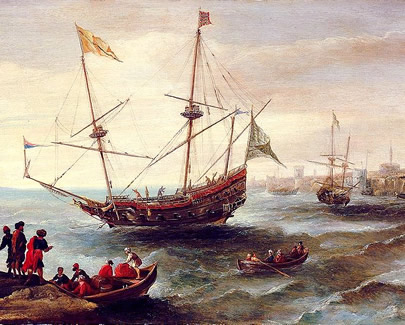
Artist: Andries van Eertvelt - A North African Port (17thc)
by an intolerable Stupidity and want of Judgment, they got so far to Leeward [downwind] of their Port, that despairing to regain it, or any of the Windward [upwind] Parts of Africa, they were obliged to go back again with the Trade-Wind, for the West-Indies; which had very near been the Destruction of them all. Surinam [Suriname, South America] was the Place now designed for, which was at no less than 700 Leagues [about 2400 miles] Distance, and they had but one Hogshead of Water left to supply 124 Souls for that Passage, a sad Circumstance that eminently exposes the Folly and Madness among Pyrates.1
Why Roberts' pirates didn't sail along the coast of Africa to find a watering location before venturing across that ocean is not explained. Their only hope of getting fresh water once they left was from rainfall. Roberts seems to have had more than a little trouble supplying adequate water to his crew. It was reported that while sailing from Newfoundland to the Caribbean, he missed the island he was heading for "and being short of Water, supplied themselves at Tobago"2.
Lack of water was a problem that cut across all types of sailors. Edward Barlow was a man who never turned pirate, choosing instead to sail as a merchant, often with the East India Company, or with the British navy. Near the beginning of his diary he said, "And looking about me on every side and seeing so much water... little did I think that I should ever want water to drink, not knowing that the sea water was salt, or that many times afterwards I should have been glad of a drink of fresh water when I was in a hot country."3
Even Stephen Martin, British Royal Navy flag captain to Sir John Leake during the Cadiz Expedition in 1702, describes how "‘the want of water [is] increasing daily, and abundance of men [are] dying through excessive heat, which the calms they had from time to time rendered more intolerable"4. Modern historian and former sea surgeon John Keevil adds that this occurred when "conditions in the ill-ventilated and overcrowded ships, lying becalmed off the African coast, were exacerbated by lack of light clothing and by the heavy manual work: deaths from heat-stroke and heat exhaustion were the inevitable outcome."5
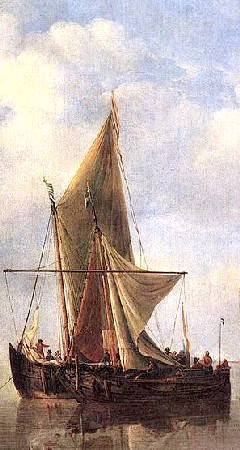
Artist: Willem van de Velde II
Calm Sea (Late 17th century)
Becalmed ships were the bane of adequate fresh water supplies. If a ship were a galley, it would have sweeps (oars), which could be used to move the vessel until the wind picked up. If it did not, it had to rely on the wind to move it in a meaningful way. When the wind failed to deliver, the ship and its crew were stuck where they were, relying on slow-moving currents and whatever fresh water was aboard to quench their thirst.
While sailing his jury-rigged ship after being defeated by pirate captain Edward England, Captain Mackra wrote that they had to go on short water ration and were "almost in despair of ever seeing Land, by Reason of the Calms we met with between the Coast of Arabia and Malabar [India]."6 Prisoner Philip Ashton reported that when Edward Low's crew was in desperate need of water, "they hoped to furnish themselves at Tobago, [but] the Current set so strong, & the Season was so Calm, that they could not recover [get back to] the Harbour, so they were forced to stand away for Grand Grenada, a French Island about 18 Leagues [62 miles] to the Westward of Tobago"7. Chaplain Henry Teonge, sailing on HMS Bristol In 1679, described a calm which occurred "to our great discomfort; for we have little fresh-water, and as little provisions for such a sick ship’s company. God send us a short passage!"8 Silas Told mentions how a trip from Campeche, Mexico to Jamaica (about 925 miles by sea) was expected to be "a short passage; but, to our mortification, it was a passage of fourteen weeks"9. Told notes that their water had to be rationed after 3 weeks, hinting at just how short they had expected their voyage to be. Slaver Thomas Phillips said that after a bout of stormy weather and 'troublesome' calms, "being apprehensive of a long passage, I put our men to short allowance of provisions, and to two quarts of water a man per day, boiling our provisions in salt water."10
Many of the published accounts of long voyages mention not having enough water at some point in the journey. This often resulted in the water being put on 'short' ration or allowance as mentioned by Thomas in the previous paragraph. (Keep in mind that the typical water used by a man according to the calculation which appears in the introduction on the first page of this article was at least 4 pints a day.) In 1670, while aboard the Experiment headed for the East Indies, Edward Barlow says the ship was "put to three pints of water a day for a man as soon as we came from ‘Sint Deago’ [probably Santiago, Cape Verde Islands], which made me wish many times for water out of a dish to drink, for I would have gone half a mile for a drink of water."11 (In the same passage, Barlow blames the hot weather and salt victuals for his thirst.)
\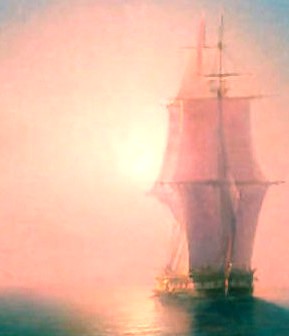
Artist: Ivan Konstantinovich Aivazovsky (19th c.)
Barlow actually had it pretty good compared to some of the other accounts, many of which mention being reduced to a single pint. On a voyage from Cirebon, Indonesia to Holland in 1685, buccaneer William Cowley reported that the ship was "brought to one Pint of Water a Man per Diem; our Water being but little in the Ship"12. His account suggests they sailed on short water rations for almost two weeks. Captain Mackra similarly reported being reduced to drinking a pint a day while sailing his ship which had been crippled by pirate Edward England's crew.13
Although the circumstances were different, when Edward Coxere's ship was captured by Spaniards in the late 17th century, he reported that the water they were given was "put into a quart bottle and sucked out with a quill; but to help [their thirst] we would keep chawing of lead to quench drouth."14 While lead probably wasn't the best choice, sucking on a hard object is a survival skill used to produce saliva and at least give the sensation of satiating thirst. Pirate captain John (Richard) Taylor's crew was similarly brought down to 'one bottle per man' and a handful or rice according to Richard Lazenby. (How much the bottle contained is not mentioned, but it is quite likely to have been about a pint.) "Had it not been for the arrack [palm liquor] and the sugar, most of them must have perished of hunger and thirst."15
A couple accounts have their victims down to less than a pint a day. Silas Told noted that during their 14 week transit from Mexico to Jamaica in 1725, they "were put to short allowance, both of bread and water; one biscuit and two thirds of a pint of water per day."16 When they missed sailing into Tobago as mentioned previously, Edward Low's crew "had been at the hardship of half a pint of Water a Man for Sixteen Dayes together"17.

Artist: Gustav Dore
Despairing Men,. From Rime of the Ancient Mariner (1876)
While off the west coast of Central America, he again ran out of potable water.
Privateer captain George Shelvocke's voyage around South and Central America and Mexico was plagued by water shortages. He left England in February of 1719, reaching Brazil in late June. He sailed around Cape Horn in September and October, commenting afterwards that "our tedious passage, and extraordinary consumption of provisions, had not only reduced us to an extreme shortness of water and wood, but of all kinds of dry provisions also"18.
On April 10, 1721, Shelvocke wrote that while they were at El Tigre island in the Bay of Fonescue, "after a hazardous and fruitless search for it [water], not only on that, but some of the greenest of the other Isles [nearby], there was not the least drop of fresh water to be found on any of them"19. Three days later, he mentioned that they had less than forty gallons of water on the ship and "we came to an allowance as half a pint of water for 24 hours, and even this allowance was rather too large, considering that there was no place that we knew of" where they could get more water.20 As a result, he said, "We constantly drank our urine, which, though it moisten'd our mouths for a time, excited our thirst the more; some attempted to drink large quantities of the sea water, which had lik'd to have kill'd them."21 Two weeks later, they were still attempting to get a supply of water, this time on Isla del Cano. However, the danger of the currents there prevented them from getting enough, resulting in another restriction of 'only a quart' of water per man.22 Frustrated, Shelvocke was forced to backtrack almost 200 miles to Coiba Island where he knew there was water.
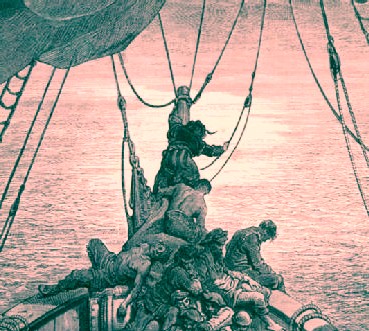
Artist: Gustav Dore
Water, Water, Everywhere... From Rime of the Ancient Mariner (1876)
The prize for least amount of water allowed per man per day goes to our old poor planner Bartholomew Roberts and the long journey across the Atlantic from Africa to South America. Charles Johnson states that they "came to an Allowance of one single Mouthful of Water for 24 Hours."23 It goes on, practically parroting Shelvocke's account, explaining that the crew "drank their Urine, or Sea Water, which, instead of allaying, gave them an inextinguishable Thirst, that killed them"24. (In fact, knowing Johnson's additions and flair for drama, that whole story may have been borrowed from Shelvocke's account.)
Sea water and urine can indeed be deadly to humans. "While humans can safely ingest small amounts of salt, the salt content in seawater is much higher than what can be processed by the human body. Additionally, when we consume salt as part of our daily diets, we also drink liquids, which help to dilute the salt and keep it at a healthy level."25 The human kidneys can only generate urine which is less salty than sea water, so excess salt gets retained. As a result, drinking salt water requires a person to urinate more, which means they must drink more regular water to get rid of the excess salt. (From this, the problem of repeatedly drinking what will become increasingly salty urine in this situation can also be seen.) As Samuel Taylor Coleridge's ancient mariner complained, Roberts' men had "Water, water, everywhere, Nor any drop to drink"26.
One clever pirate captain managed to use a lack of water (among other things) to get his way. John Gow and his crew had taken several ships near Portugal and were debating where to go next.
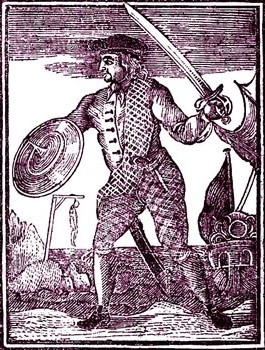
Pirate Captain John Gow, From the General History
of
the Pyrates, p. 112 (1725)
Some wanted to go to Africa, others lobbied for the Gulf of Mexico, another group suggested heading for the North American colonies while still others suggested Florida or Honduras. Captain Gow wanted to return to his homeland: Scotland.
To bring them with this Design he represented the Danger they were in where they were [the coast of Portugal], (as above) the Want they were in of fresh Water, and of several kind of Provisions, but above all, the Necessity they were in of careening and clearing their Ship; that it was too long a Run for them to go to the Southward, and that they had not Provisions to serve them till they could reach any Place proper for that Purpose, and might be driven to the utmost Distress, if they should be put by from Watering, either by Weather or Enemies.27
Enough of the crew agreed, so they sailed to the Orkneys. Once there, Gow knew that they would have to have a good excuse to give to the locals for their stopping there. He told his crew to tell anyone who asked that they were merchants sailing from Cadiz, Spain to Stockholm, Sweden. However, "they had a long Passage, by reason of contrary Winds, and [had] lost their Opportunity of passing the Sound, which was now full of Ice, if not frozen up; and that they had been driven so far to the Norward by Stress of Weather, that they wanted Water and fresh Provisions, and to clean their Ship; that they would pay for whatever they were supply’d with"28. A lack of water had come to Gow's aid once again, this time as an excuse for stopping in the Orkneys.
1 Captain Charles Johnson, A general history of the pirates, 2nd Edition, 1724, p. 241; 2 American Weekly Mercury, Vol 1, 1719-1720, The Colonial Society of Pennsylvania, 1898, p. 138; 3 Edward Barlow, Barlow’s Journal of his Life at Sea in King’s Ships, East and West Indiamen & Other Merchantman From 1659 to 1703, p. 32; 4,5 John J. Keevil, Medicine and the Navy 1200-1900: Volume II – 1640-1714, 1958, p. 212; 6 Johnson, p. 122; 7 Philip Ashton, Ashton's Memorial, 1726, pp. 30-1; 8 Henry Teonge, The Diary of Henry Teonge, Chaplain on Board H.M.’s Ships Assistance, Bristol, and Royal Oak, 1675-1679, 1927, p. 253; 9 Silas Told, An Account of the Life, and Dealings of God with Silas Told &c., 1786, p. 15; 10 Thomas Phillips, 'A Journal of a Voyage Made in the Hannibal', A Collection of Voyages and Travels, Vol. VI, Awnsham Churchill. ed., p.236; 11 Barlow, p. 182; 12 William Ambrosia Cowley, "Cowley’s Voyage Round the Globe" from William Hacke’s book A collection of original voyages, 1993, p. 31; 13 Johnson, p. 122; 14 Edward Coxere, Adventures by Sea of Edward Coxere, 1946, p. 112-3; 15 “56. Richard Lazenby, a prisoner of John Taylor, from The Narrative of Richard Lazenby", Pirates in Their Own Words, Ed Fox, ed., 2014, p. 284; 16 Told, p. 14; 17 Ashton, p. 31; 18 George Shelvocke, A Voyage Round the World by Way of the Great South Sea, 1726, p. 76; 19 Shelvocke, p. 347; 20 Shelvocke, p. 350-1; 21 Shelvocke, p. 351; 22 Shelvocke, p. 353-4; 23,24 Johnson, p. 122; 25 "Can humans drink seawater?", National Oceanic and Atmospheric Administration Website, gathered 6/7/17; 26 Samuel Taylor Coleridge, The Rime of the Ancient Mariner, 1857, p. 17; 27 Select and Impartial Accounts of the Lives, Behavior, and Dying-Words Of the most Remarkable Convicts, Vol. II, 1745, p. 229; 28 Select and Impartial Accounts, p. 230
Problems with Fresh Water at Sea - Land-Based Procurement
Locations sometimes presented difficulties to sailors who wanted to quickly procure water and go. While at 'St. Jago' (Santiago, Cape Verde Islands) in 1703, William Funnell explained, "Here is good Water to be had, but troublesome
\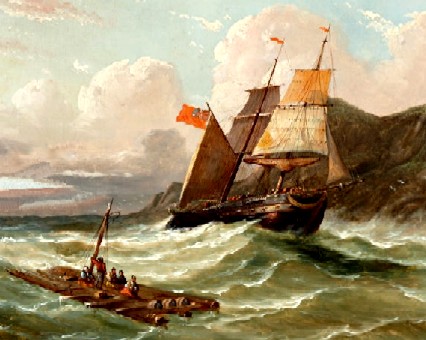
Artist: Egide Linnig - Raft and Sailing Ship Near Coast (c. 1844-60)
fetching of it"1 without explaining why. He does elsewhere note that the island has "many Rocks and Shoals, so that it is bad going into them", but he also notes that the island's main port, Port Navidad, "is a very good Port, in which is Water and Wood."2
Merchant slaver Thomas Phillips ran into some trying situations during a voyage in attempting to get water. While at Santiago in the Canary Islands in December of 1693, his crew had to get water from a well which was so shallow that they were "oblig’d to hand [the water] up in buckets, [which] occasion’d a tediousness in filling our casks, and disturb’d the water to that degree, that it was as thick as puddle, so that it serv'd us for no other use but to boil our provisions with"3. Having to cook food in muddy water must have reinforced the misery of having such a hard time drawing it. On top of this, the trip back to the ship from the well presented hazards in the form of "damage to our casks, in rolling them so far over sharp rocky fragments".4
Six months later, while at St. Thomas in the Caribbean, Phillips left two men ashore each night just to fill small hogshead casks with water. They were then rolled "them over the sand to the sea-side, ready to raft off in the morning, before the sea breeze came in, which is the only time [they could be taken off], we having no other way to get it off but by rafting, and in halling [the hogsheads] off to the longboat the great sea[, which] would often break our raft, and stave our cask, whereby we lost a great many."5
\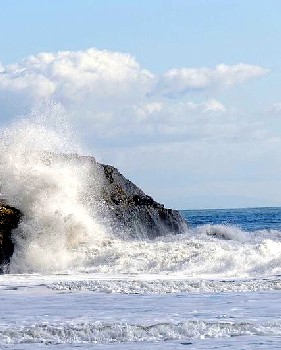
Photo: Don DeBold
Sailor Edward Barlow gives a most colorful and detailed account of the challenges faced at a location while watering on Tenerife in the Canary Islands in 1668. He explains,
...to fetch water from the shore it was very dangerous many times, for we must fetch it at a great steep rock, which the swell of the sea would sometimes swell up to the top of, and then fall down five or six yards all upon a sudden, and we must always watch the swell of the sea, and when it came up to the top of the rock, roll our barrels of water into it, and let the sea, as it descended, take them down; and if you should chance to miss rolling the cask (as you must be very quick and nimble in doing it just as the sea came up, for it was gone again in an instant), then your cask would fall down the steepness of the rock seven or eight yards before it would come into the water, and many times broke in pieces; it being the worst place that ever I was in to get fresh water at.6
Because of this, Barlow says that the men were forced "many times to drink good wine when we would have drunk water"7. One can easily see what a hardship it must have been for those men.
Just as it created troublesome waves for Barlow, the weather could pose other problems for ships attempting to recruit water. This usually took the form of strong winds. Pirate John (Richard) Taylor's ship was blown off the Laccadive Islands in India by strong winds, causing them to lose several anchors and leave 70 of their men and their water casks on the shore. "It was ten days before they again made the Island and took aboard their men and their water."8
When the East Indiaman Mary ran short of water, she sailed for eastern Madagascar to refill the casks. The crew tried to send their long boat ashore but couldn't get there because of the surf. Sailor David Williams and another man were asked to go ashore from the longboat because they were good swimmers. Once there, the wind picked up, which "caused the surf to run too high for them to get off; and the long-boat, after waiting some time, seeing no possibility of getting these men on board, weighed and stood for the ship, which filled her sails and stood for St, Augustin's Bay [Madagascar], where she watered, and proceeded on her voyage."9 So much for David Williams and his friend.
\
Photo: Pedro Simoes
Similarly, Woodes Rogers' privateers were planning to get water for his ships at St. Vincent in the Cape Verde Islands in 1708, but the wind prevented this because it was blowing so hard that their boats couldn't get ashore. Needing the water, they were forced to wait for the morning and even then were forced to tie "a Rope from the Ship to the watering-place, which is a good half-mile from our anchoring-place, and so haul’d our empty Casks ashore by Boat-loads"10 (Necessity is indeed the mother of invention.)
Rogers is not the only sailor to employ simple engineering techniques to get much-needed water onto a vessel. When William Dampier returned to Pulo Condore (modern Côn Son Island off Vietnam) in 1687, he expected to find water on the north side of the island as he had in a previous journey. "But we found it dried up, only it stood in Holes, two or three Hogsheads or a Tun in a Hole: Therefore we did immediately cut Bamboes, and made Spouts, through which we conveyed the Water down to the Sea-side; by taking it up in Bowls, and pouring it into these Spouts or Troughs."11
As briefly mentioned, William Funnell described a similar venture in 1705 at what is today called Conchagüita, El Salvador. The crew found rainwater had flowed from the mountains and pooled on the opposite side of a hill. Funnell explained that the hill was high and so difficult to climb that they could barely manage it without having carry casks of water. So the crew cleared the plant growth on either side of the hill, cutting steps into the steeper land side of the hill with their axes and shovels. "And our Sail-maker having, in the mean time made us a Canvas-Pipe of about ninety fathom long to carry our water from the top of Hill down to our Cask [probably a Tun] which lay at the foot of it; we went to work to fill our water; each Man having with him a six Gallon Cask."12 The men dipped their 6 gallon casks in the water, carried it up the steps they had made to the mouth of the canvas pipe and then poured it in to flow into the larger cask at the bottom of the hill on the other side. "Thus we employed our selves for four days."13 At the end of those days, they had 25 Tuns of water, which they felt would last longer than their supply of food.
In other places, the work required was a little more basic; several accounts mention digging to get at fresh water. Jeremy Roch
\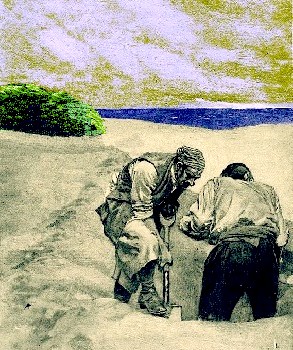
Artist: Howard Pyle
You Thought Pirates Only Dug to Bury Treasure? (pre-1911)
commented that Hoylake, England was "a very convenient place for a fleet to lie... for all the shore along is fine sand and ships may hale [haul] ashore there without any danger... and you find fresh water enough by digging little pits in the sand at high water mark."14 When his ship Revenge stopped at São Nicolau in the Cape Verde Islands, William Cowley reported that they "digged three Wells, in order to get fresh Water to water our Ship"15.
William Dampier mentions digging for water several times in his various accounts. On the river-free Yucatan peninsula in Mexico in 1675, he advised those searching for water to go to the midway point between Cape Candecedo (modern Reserva de la Biosfera Ría Celestún, Mexico) and Salinas (Real de Salinas, Mexico) where "you may dig in the Sand above High-Water Mark, and find very good fresh Water."16 The northern Yucatan peninsula still today relies on this aquifer from which groundwater can be extracted.
Dampier says in 1687 that the Bataan islands north of the Philippines are "pretty well watered with small Brooks of fresh Water, that runs flush into the Sea for ten Months in the Year"17. However, this was not the case in April. He explains when visiting during that time, "you shall have none [no water] in the Brooks, but what is lodged in deep Holes; but you may dig Wells in some places."18
During Woodes Rogers' privateering voyage, captain Edward Cooke noted that while at Puerto Vermejo (which appears to be near modern La Gramita, Peru) there was 'fresh Water by the Sea'. He noted that there was a small well there. In addition, "wheresoever you go but 10 or 12 Paces from the Sea, dig in the Sand half a Fathom, and you’ll find reasonable good Water, not very brackish (salty)."19
In fact, the dry season created difficulty getting fresh water in many places. When discussing a river he named Ylo (near Yerba Buena, Peru which is not shown on current maps) William Funnell noted that it, like "most of the other Rivers of Peru, runs with a quick Current from the beginning of January till the latter end of June; and then it decreases running slower and slower, till the latter end of September; After which it wholly fails, and becomes dry; the Waters not beginning to run again, till January."20
When pirate captain John (Richard) Taylor visited the island Fernando de Noronha, Brazil, Richard Luntly reported that "they thought to get Water there, which at length they found a small Place that yielded some Water, but it being the dry
\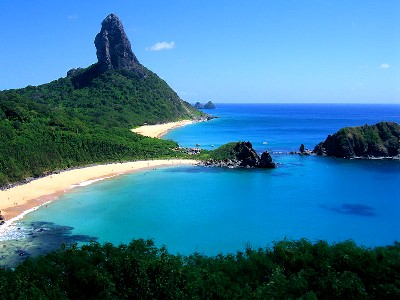
Photo: Flickr User photo pantai - Ferdenando de Noronha, Brazil
Time, that Way they made a Shift for to fill about nine But[t]s of Water"21. At least they could get something. Others were not always so lucky during the dry season. Buccaneer captain Edward Davis visited the Pearl Islands off Panama in March of 1685, where Dampier reported that the water, "of which there was plenty when we first came hither, was now dried away."22 So they left Panama in search of better watered pastures.
The dry season could be tricky to predict. During Woodes Rogers privateering voyage, Dutchess captain Edward Cooke reported than on May 13 of 1709 they thought they were near "the Galapagos Islands, where we design'd to water, fit our Ships, and refresh our Men"23. Although May is actually near the end of the rainy season there, what followed was a frustrating series of attempts to find water. On Thursday, May 18th, the crew searched two of the islands for water but found none. They spent the weekend "plying among the Islands… Our Pinnace went ashore to look for Water, but found none on the great Island [today called Isla Isabella], which is most a Rocky dry Ground"24. They continued to look for water until the Thursday following, when a consultation was called between Rogers, Cooke and physician Thomas Dover (honorary captain of the prize ship Nuestra Señora de la Encarnación y Desengaño) resulting in their heading for Isla de Plata, Ecuador to get water.
\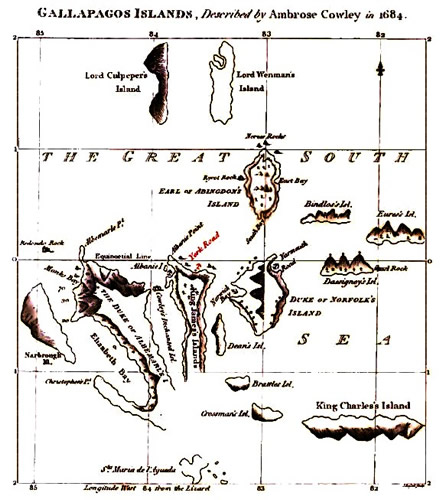
William Cowley's Map of the Galapagos Islands (1684)
Even in the rainy season the Galapagos would have been a curious choice, given that they have very limited fresh water supplies. "Springs have very low flow rates and streams run sporadically."25 Much would likely have depended on how much and how recent the rainfall had been. "The abundance
of water varies greatly from exceptionally rainy years (El Niño) to years of severe drought (La Niña)."26 However, this would not have been known to Cooke who explained that their fleet was relying on William Cowley's glowing account of the Islands as their guide.
Cowley had visited the Galapagos in March of 1684, right in the middle of the rainy season for those islands. He said that the Bay of Albany on the island which he called Duke of York contained "excellent, good, sweet Water, Wood, &c. and a rich Mineral Ore."27 Which island this is isn't entirely clear. Cowley includes a map which, while it bears passing resemblance to the actual islands, becomes confusing when examined closely. To add to the confusion, Cowley does not specifically show Duke of York Island nor Albany Bay on his map. There is a York Road and nearby anchorage (shown on his map at right in red), but that is all.
It becomes easier to see why Rogers' men spent so many frustrating days searching these islands for water if they were relying on Cowley to get them to his recommended spot. Given the difference in season and the fact that and the amount of water can vary widely from year to year (relying primarily on rainfall and a heavy mist called 'garúa'28), it can readily be seen why Rogers' men had so much trouble finding water in the Galapagos.
Perhaps the most unusual problem trying to get water is mentioned by Basil Ringrose while they were at Juan Fernandez Island in Chile in 1679. "Here it was observable, that we were
\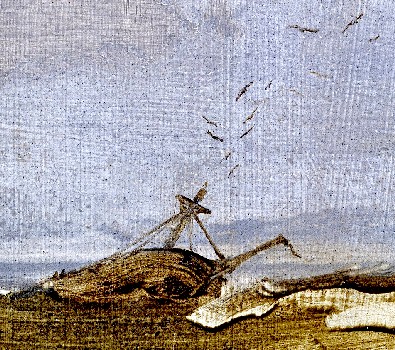
Artist: Peder Balke - Coastal Landscape with Ship Wreck (c. 1860-1869)
forced to keep men ashore on purpose to beat off the seals, while our men filled water, at high-water mark, because the seals covet greatly to lie in fresh water."29
Juan Fernandez was also the site of one of the most dramatic difficulties encountered while procuring water. Finding they were in using a lot of water each day, privateer George Shelvocke's stopped there in May of 1720. He "prepared 20 tons of casks to raft ashore, then work'd [the ship] in, and anchored, according to the best directions I had, in 40 fathom water, and made a warp, which was of the length of 3 hawsers and half, which was made fast to the rocks to steady the ship, and by which we haul'd our raft of cask ashore and aboard."30 A 'hawser' is a large thick rope used to tow a ship. 'Making a warp' refers to setting an anchor or tying a hawser to something (such as rocks) which is in the direction you want to move a vessel. The hawser is then pulled into the ship, causing the vessel to move towards the anchored position. When Shelvocke got into the right position, a gust of wind arose, causing the hawser to break and the ship was pushed onto the rocks, wrecking her. The crew spent the next four months building another small craft so that they could leave the Juan Fernandez. Shelvocke gives another small insight into the problems this created with water when they left. Because so many of their supplies had been destroyed in the shipwreck or ruined while residing on the deserted island, "there was not a drop of water to be had without sucking it out of the cask with the barrel of a musquet, which was made use of by every body promiscuously"31.
1 William Funnell, A Voyage Round the World, 1969, p. 5; 2 Funnell, p. 92; 3,4 Thomas Phillips, 'A Journal of a Voyage Made in the Hannibal', A Collection of Voyages and Travels, Vol. VI, Awnsham Churchill. ed., p.183; 5 Phillips, p. 229; 6,7 Edward Barlow, Barlow’s Journal of his Life at Sea in King’s Ships, East and West Indiamen & Other Merchantman From 1659 to 1703, p. 167; 8 “56. Richard Lazenby, a prisoner of John Taylor, from The Narrative of Richard Lazenby", Pirates in Their Own Words, 2014, Ed Fox, ed., p. 280; 9 Captain Charles Johnson, The History of the Pirates, 1829, p. 183; 10 Woodes Rogers, A Cruising Voyage Round the World, 2004, p. 25; 11 William Dampier, A New Voyage Round the World, 1699, p. 398; 12 Funnell, p. 219-20; 13 Funnell, p. 220; 14 Jeremy Roch, "The Fourth Journal of Jeremy Roch", Three Sea Journals of Stuart Times, Bruce S. Ingram, ed., 1936, p. 118; 15 William Ambrosia Cowley, "Cowley’s Voyage Round the Globe", A collection of original voyages, William Hacke, ed., 1993, p. 2; 16 William Dampier, A Supplement of the Voyage Round the World, Part II, 1700, p. 42; 17 Dampier, A New Voyage Round the World, 1699, p. 393-4; 18 Dampier, A New Voyage Round the World, 1699, p. 394; 19 Edward Cooke, Voyage to the South Seas, Volume 2, 1712, p. 176; 20 Funnell, p. 194; 21 “27. Richard Luntly, from The Last Speech and Dying Words of Richard Luntly (Edinburgh, 1721”, Pirates in Their Own Words, Ed Fox, ed., 2014, p. 123; 22 Dampier, A New Voyage Round the World, 1699, p. 198; 23 Edward Cooke, A Voyage to the South Sea and Round the World in the Years 1708 to 1711, 1969, p. 153; 24 Cooke, p. 156; 25 Noémi d'Ozouville, "Fresh water: the reality of a critical resource", Galapagos Report, 2006-2007, p. 147, gathered from the internet 6/9/17; 26 d'Ozouville, p. 146; 27 Cowley, p. 10; 28 d'Ozouville, p. 146; 29 Basil Ringrose, The Buccaneers of America, 1856, p. 252; 30 George Shelvocke, A Voyage Round the World by Way of the Great South Sea, 1726, p. 204-5; 31 Shelvocke, p. 259

